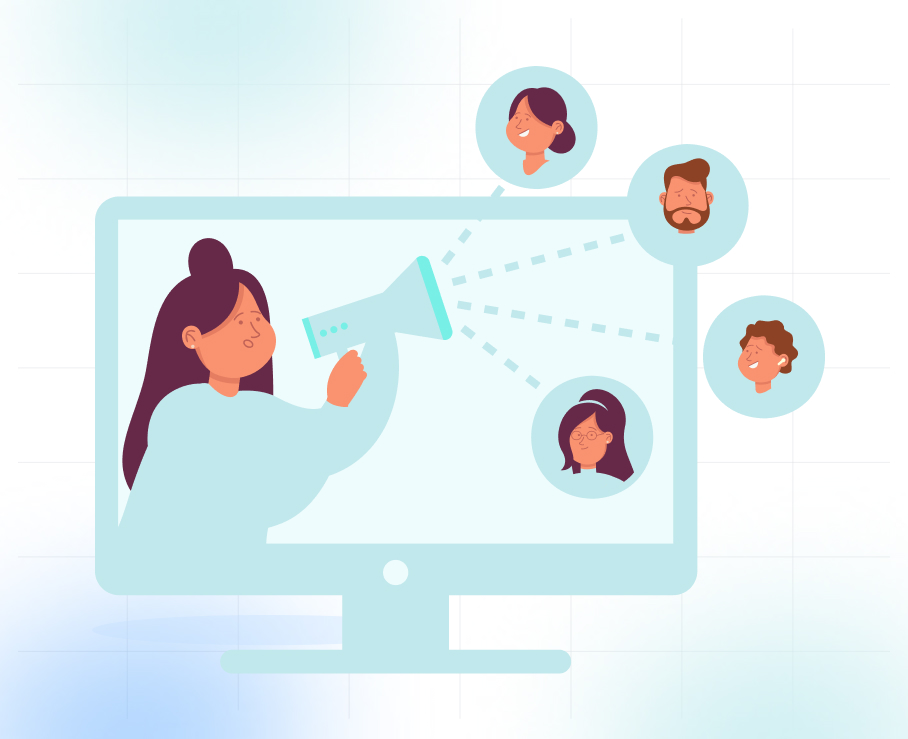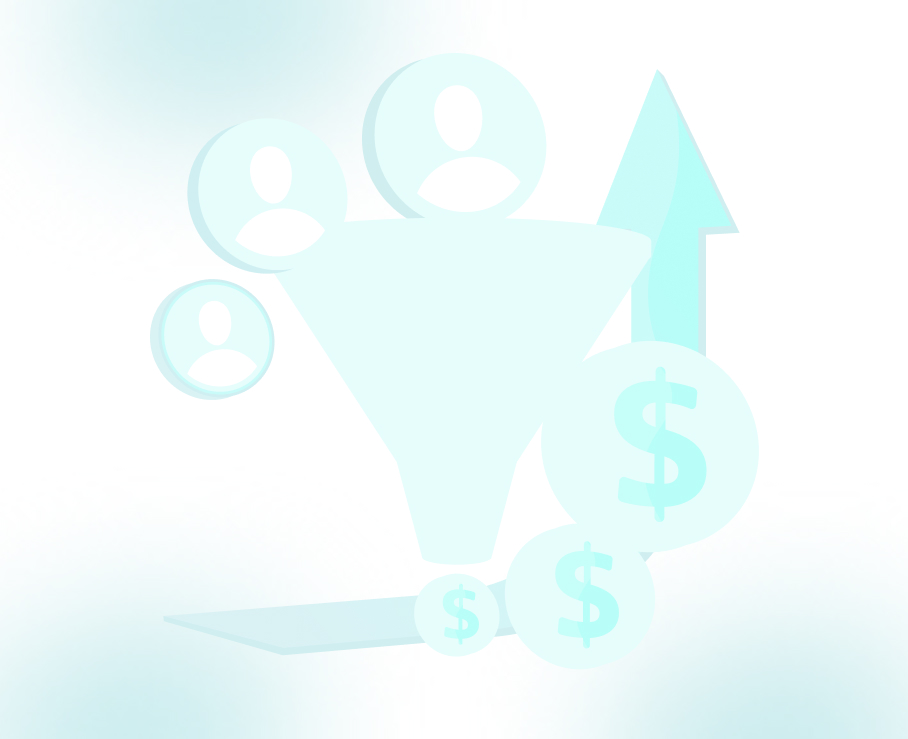
What are Leads in Business and Their Importance?

Maintaining steady monthly recurring revenue (MRR) is one of the biggest challenges B2B businesses face today, especially without a consistent flow of qualified leads. Without a reliable stream of interest-driven contacts, sales teams often spend more time chasing than closing, making revenue projections harder to meet.
In simple terms, a lead in business is anyone who has shown interest in your product or service and has the potential to become a customer. This interest could come through a reply to an outreach email, a form submission, or a request for more information. Leads are the starting point of every sales pipeline and directly influence how efficiently a business can grow its revenue.
This article breaks down what leads mean in a business context, how to differentiate between types of leads, why they matter to your sales process, and how B2B companies can focus on generating high-quality leads that actually convert.
What are Leads in Business?
A lead in business refers to an individual or organization that has expressed interest in your product or service, typically by sharing their contact information, such as an email address, phone number, or by filling out a form. This interest signals a potential intent to engage further, placing the lead at the very beginning of the sales process.
Leads sit at the top of the sales pipeline. They represent raw opportunities; some may convert quickly, while others may never progress. That’s why identifying and qualifying them early is essential to avoid wasted effort and improve conversion rates down the line.
Difference Between a Lead and a Prospect
While often used interchangeably, “lead” and “prospect” refer to different stages in the sales funnel. A lead is someone who has shown initial interest but hasn’t yet been evaluated for fit or intent. In contrast, a prospect is a lead that has been qualified, someone who matches your ideal customer profile and shows genuine potential to convert.
Understanding this difference is crucial for sales prioritization. Treating every lead like a ready buyer can waste valuable resources. Prospects are further along in the funnel and require more personalized and direct engagement, while leads need nurturing until they’re ready to move forward.
Also Read: Lead Generation: Proven Strategies and Expert Tips to Boost Your Sales
Types of Leads & What They Mean for Your Sales Pipeline
Classifying leads helps you structure your pipeline, prioritize outreach, and match sales efforts to readiness.
Based on Engagement: Cold, Warm, and Hot Leads
This classification indicates the level of familiarity or interest a lead has in your offering. It’s one of the first filters to decide how much effort and what kind of messaging to apply.
- Cold Leads: No prior interaction or brand awareness. Outreach typically starts from scratch with educational or introductory content.
- Warm Leads: Some engagement, such as website visits, email opens, or content downloads. These leads may need more nurturing before a sales conversation.
- Hot Leads: High-intent leads showing buying signals, such as filling out a contact form or requesting a quote, are ready for sales engagement.
Based on Funnel Qualification: MQL, SQL, and PQL
These lead types indicate how far a lead has progressed in the funnel and how closely they match your ideal buyer criteria.
- Marketing Qualified Leads (MQLs): Leads who’ve interacted with marketing campaigns and meet preliminary criteria (e.g., industry, company size) but aren’t ready for sales contact yet.
- Sales Qualified Leads (SQLs): Leads who’ve shown higher intent and meet firmographic and behavioral benchmarks. These are passed to sales for active follow-up. At The Lead Market (TLM), we qualify Sales-Qualified Leads (SQLs) based on real buying signals, not guesswork. Over 90% reach the proposal stage, and approximately 80% proceed to close. When your team is ready to focus on serious buyers, we’ll help you find them. Click here to know more.
- Product or Service Qualified Leads (PQLs/SQLs): Leads who’ve shown strong buying signals through actions like using a trial version, requesting pricing, or engaging directly with a product or service feature.
For businesses like MSPs or staffing firms, identifying SQLs early ensures sales teams spend time only on the leads most likely to convert and contribute to monthly recurring revenue (MRR).
Using Lead Scoring to Prioritize Outreach
Lead scoring assigns value to each lead based on fit and engagement. This helps teams focus on quality, not just quantity. A typical lead scoring model combines the following:
- Decision-making potential (seniority, department, budget authority)
- Buying intent (content interactions, frequency of visits, time spent on site)
The higher the score, the more likely the lead is to convert. For B2B teams, especially in high-value sales cycles, lead scoring enables more precise and scalable pipeline management.
Recommended: Top 8 Strategies for Successful Targeted Lead Generation.
What are the Characteristics of a Good Sales Lead?
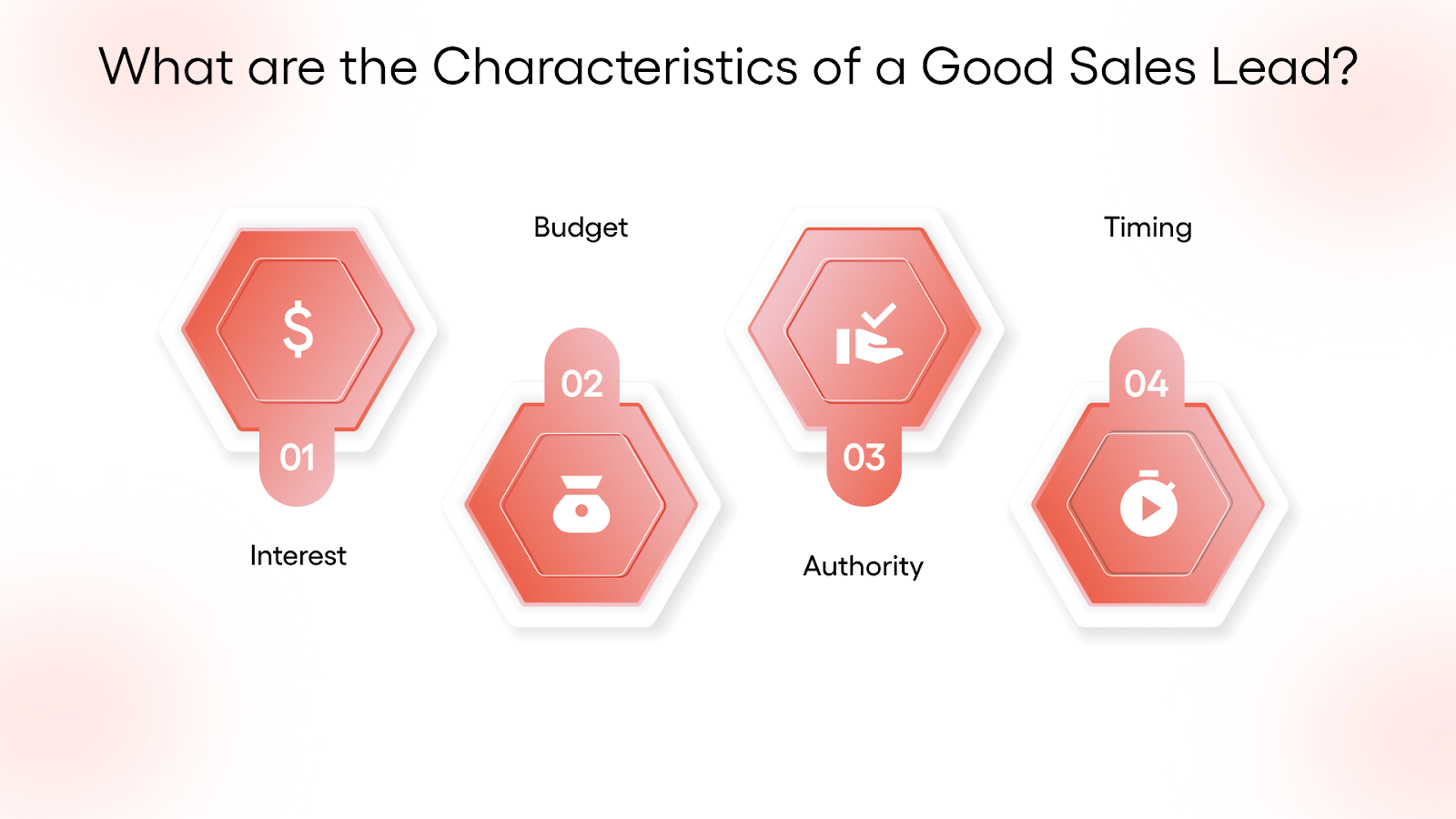
When evaluating which leads are worth pursuing, start with how well they match your ideal customer profile (ICP). A strong lead fits your target criteria, such as company size, job role, or industry focus. For instance, if you specialize in supporting MSPs, a good lead might be an Operations Head at a 100-employee IT firm looking to improve client onboarding.
Once fit is established, look for the following characteristics:
- Interest: Beyond surface fit, a good lead shows active engagement. They’ve opened your emails, signed up for a free trial, or downloaded a resource, signs they’re looking for a solution like yours.
- Budget: They don’t need to share exact numbers, but early cues, like their company’s growth stage or tech stack, can indicate whether they can afford your solution. This prevents time spent on contacts who are unlikely to convert.
- Authority: Progress stalls when you're speaking to someone without influence. A high-quality lead typically has decision-making power or plays a direct role in the purchase process.
- Timing: Some leads are still researching, while others are ready to make a change. Prioritize those facing an urgent challenge or working within a defined buying window.
When leads show strong fit, clear interest, and the right mix of budget, authority, and timing, they’re far more likely to move forward in your sales process. These traits are often used in lead scoring models to help teams prioritize outreach.
Once you know what a good lead looks like, the next step is attracting more of them, consistently and at scale. The next section covers where to find these leads and how to bring them into your funnel effectively.
Also check our blog, What Your Sales Team Should Do with Marketing Qualified Leads.
What are the Sources of Business Leads?
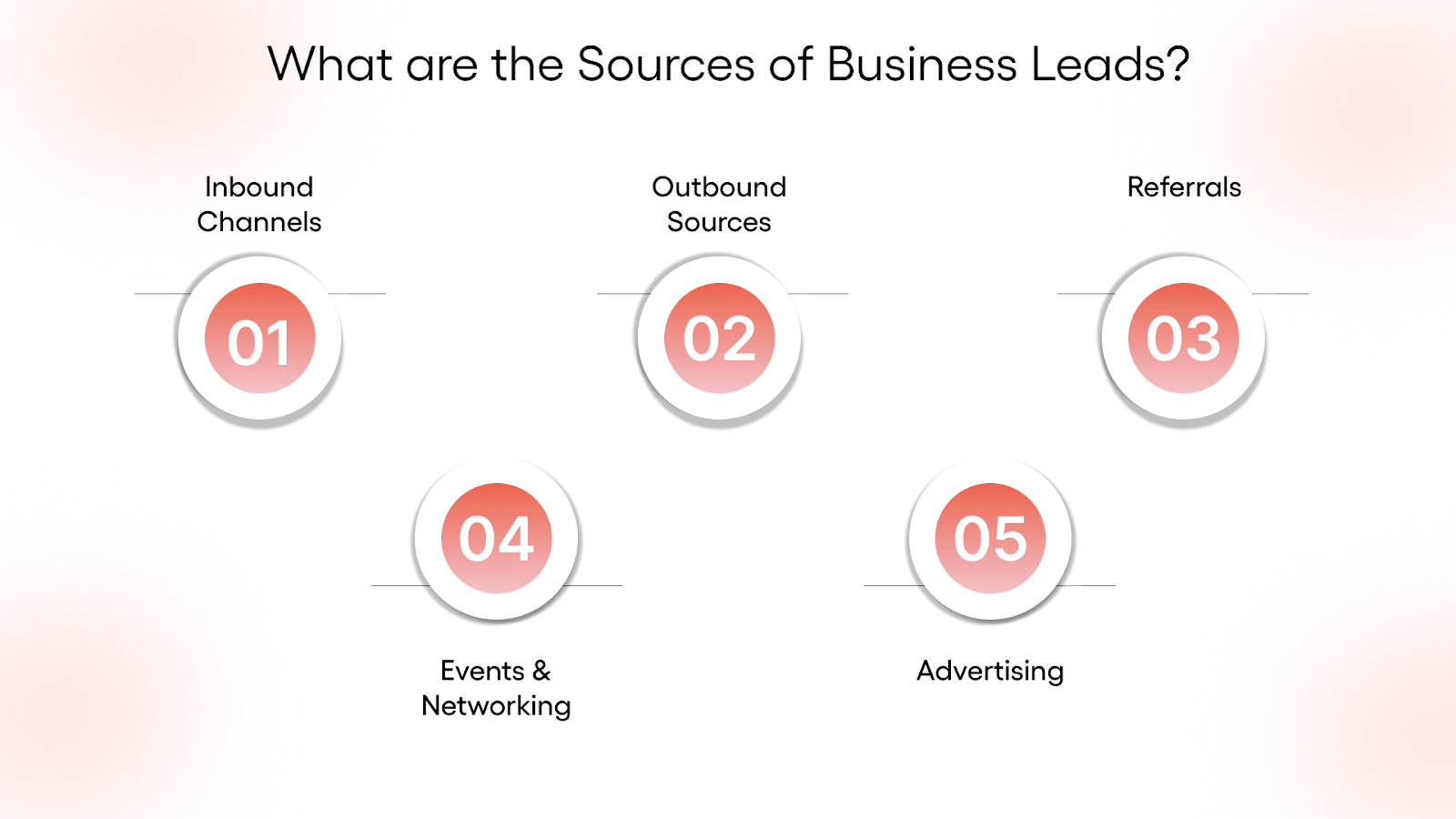
Maintaining a healthy sales pipeline requires consistently generating new leads across multiple channels. These sources typically fall into three buckets: inbound, outbound, and referral-based.
1. Inbound Channels
These leads come to you. Channels include your website, content marketing, SEO, and social media. When someone fills out a contact form, downloads a resource, or subscribes to your updates, they’ve shown intent and given you a chance to follow up. Inbound leads often convert better because they’re already interested. For example, a well-placed lead magnet on your website or a targeted blog post can draw in qualified prospects organically.
2. Outbound Sources
Outbound efforts involve directly reaching out to potential leads. This includes emails, LinkedIn prospecting, and cold calling. Though outbound takes more effort upfront, it lets you define your target audience with precision and control the pace of your outreach. For B2B firms selling to defined verticals, such as MSPs or SaaS companies, outbound helps fill the gaps left by passive channels.
3. Referrals
Referrals come with built-in trust and usually shorter sales cycles. They often stem from satisfied clients, industry contacts, or even current partners. You can encourage referrals through simple asks or structured programs that reward introductions.
4. Events and Networking
Trade shows, webinars, roundtables, and even LinkedIn groups can surface valuable contacts. These spaces offer real-time engagement, allowing you to connect with intent-rich prospects and establish personal rapport quickly.
5. Advertising
Paid campaigns can expand your reach across both digital and traditional platforms. From PPC and display ads to industry newsletters or even print ads, help you capture leads outside your organic sphere, especially useful when scaling fast.
Now, the real challenge lies in turning those contacts into meaningful opportunities. That’s where the right lead generation and nurturing strategies come in.
6 Proven Strategies to Generate & Nurture Leads
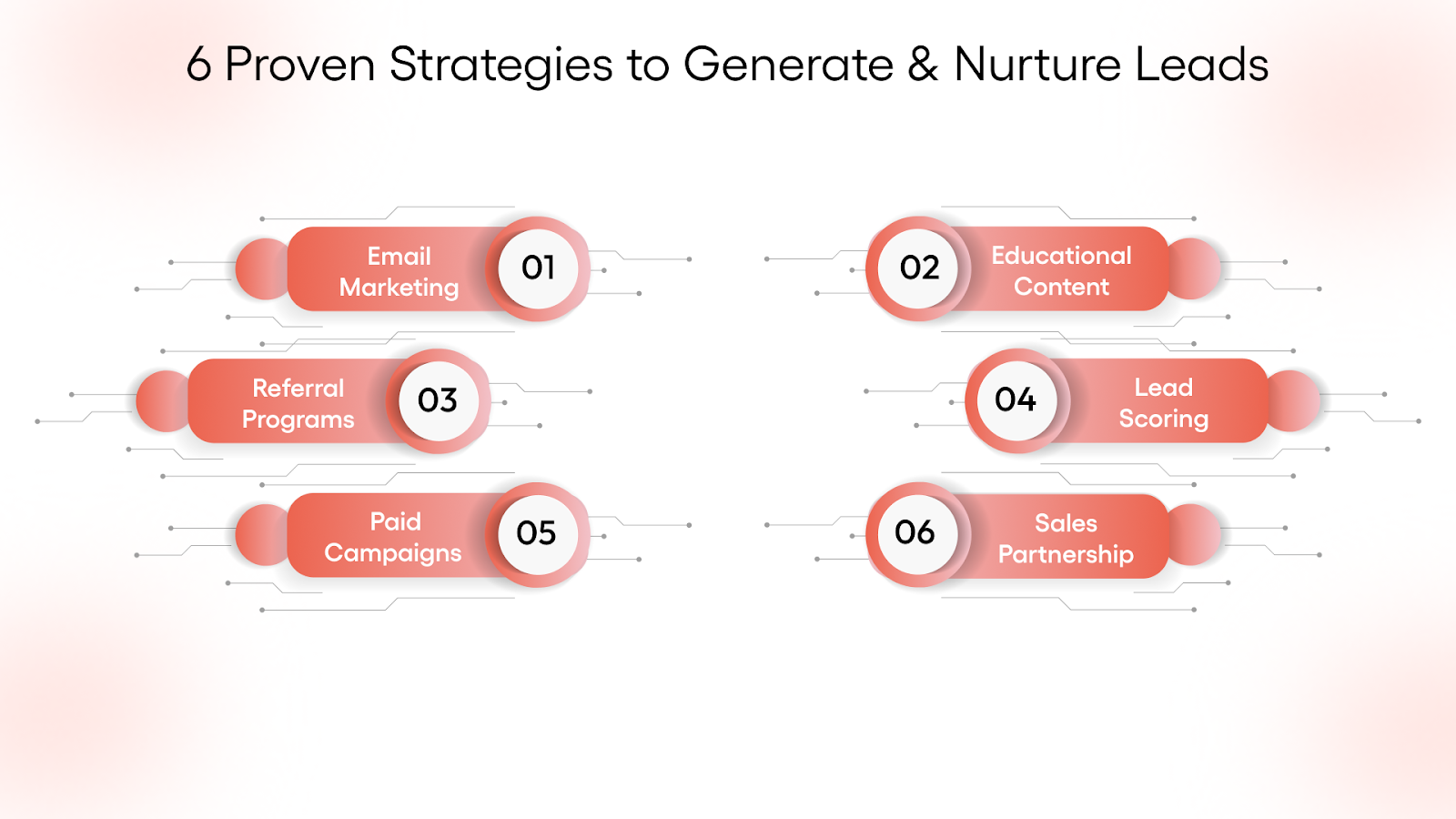
Driving high-quality lead generation means combining well-targeted tactics with consistent nurturing. Here are key strategies that work for B2B firms like MSPs, tech providers, and staffing agencies:
1. Email Marketing
Email continues to outperform many other B2B channels in terms of both reach and ROI. As of 2025, the average open rate across industries has risen to 42.35%, the highest it’s been in years, reflecting both improved targeting and growing trust in personalized outreach.
Unlike cold calling, which often relies on timing and availability, email marketing gives you a scalable way to reach decision-makers on their terms. It offers a structured, measurable format for sharing value-driven content, nurturing leads through the funnel, and building familiarity over time.
Whether you’re introducing a new product or moving warm leads closer to a conversation, email gives you the flexibility to craft journeys that align with buying behavior.
Here’s how to make it work:
- Share gated content like case studies, eBooks, or ROI calculators to identify leads with high intent.
- Use drip sequences that adapt to lead behavior and buying stage, making each message more relevant than the last.
- Segment your lists by role, industry, or buying stage to deliver content that actually resonates.
For B2B companies with long sales cycles, visibility alone isn’t enough; your emails need to land with purpose. That’s where targeted campaigns come in. When you tailor content to a lead’s job role, industry, and buying stage, you offer more than noise; you offer value.
Instead of blasting generic promotions, targeted email campaigns focus on answering the specific questions leads are already asking, based on their role, pain points, and their position in the buying journey. When done consistently, this email-driven approach builds familiarity and trust, keeps you in the inbox (not the spam folder), and makes the next step feel like a natural continuation, not a hard sell.
Read: The Future of Email Marketing and Cold Calling: Strategies to Stay Ahead
2. Inbound Content to Attract and Educate
Strong inbound strategies help you meet leads at the research phase. When you publish helpful, timely content, you position your brand as a trusted advisor, making it easier for leads to engage when they’re ready.
- Create blogs around common challenges or pain points in your niche.
- Offer downloadable resources (whitepapers, checklists) in exchange for contact details.
- Host webinars or live Q&As to capture real-time interest and feedback.
3. Referrals and Network Programs
Referrals convert better because they come with built-in trust. Especially in industries like tech and managed services, a strong referral can fast-track the entire sales process.
- Encourage satisfied customers to refer peers at logical touchpoints.
- Offer simple referral rewards or loyalty benefits.
- Participate in niche forums or communities where decision-makers gather.
4. Strategic Use of Lead Scoring
Not all leads deserve equal attention. Lead scoring helps you prioritize by combining firmographics (company size, industry) with behavioral signals (email opens, page visits, demo requests). This helps sales teams act quickly on high-intent leads.
- Assign scores based on role, engagement level, and activity.
- Adjust thresholds based on actual conversion trends.
- Share scoring data between marketing and sales for better alignment.
5. Paid Campaigns
When done right, paid outreach helps fill your pipeline faster, especially when targeting narrow B2B segments. Paid channels give you precision in who you reach and allow for continuous testing and optimization.
- Use retargeting to stay visible after the first visit.
- Always tie your ad copy to a clear offer or next step (e.g., demo, guide, consultation).
6. Partnering with B2B Sales Support Experts
Instead of building every system in-house, many growing businesses choose to partner with specialists to scale faster. For example, working with a B2B lead generation partner like TLM gives you access to ready workflows, tested lead scoring methods, and data-backed outreach strategies.
- TLM helps identify and deliver high-intent SQLs aligned to your ICP.
- Their email and content programs reduce wasted effort on low-fit leads.
- Support is built for real-world teams, especially MSPs and service-based firms.
Once a lead shows interest, the real work begins. Managing that lead effectively is what turns potential into revenue.
How a Healthcare-Focused MSP Scaled 5X with Email-Led Lead Generation
One Central Florida-based MSP, specializing in IT support for healthcare companies, saw its revenue grow fivefold within a year of partnering with TLM. Facing tough competition and an urgent need to fill gaps left by a previous client, the company sought a strategic, reliable lead generation partner.
We assigned two full-time resources to prospect and qualify companies that matched their target profile, particularly those in the healthcare sector. While our content team ran custom email campaigns aligned with their Managed IT services, we also deployed a trained lead identifier to filter high-intent responses. Unlike traditional cold calling, our email-first strategy focused on timing, personalization, and building trust, including reference checks to support conversion.
By month five, they had closed their first fully outsourced IT services deal. With an average of 2–3 leads generated monthly (some months fewer), 85% advanced to the proposal stage. This success filled the void in their pipeline and reshaped their perspective on outbound, shifting from cold calling to relying entirely on TLM's email-led approach for marketing and growth.
What to Do When You Get a Business Lead
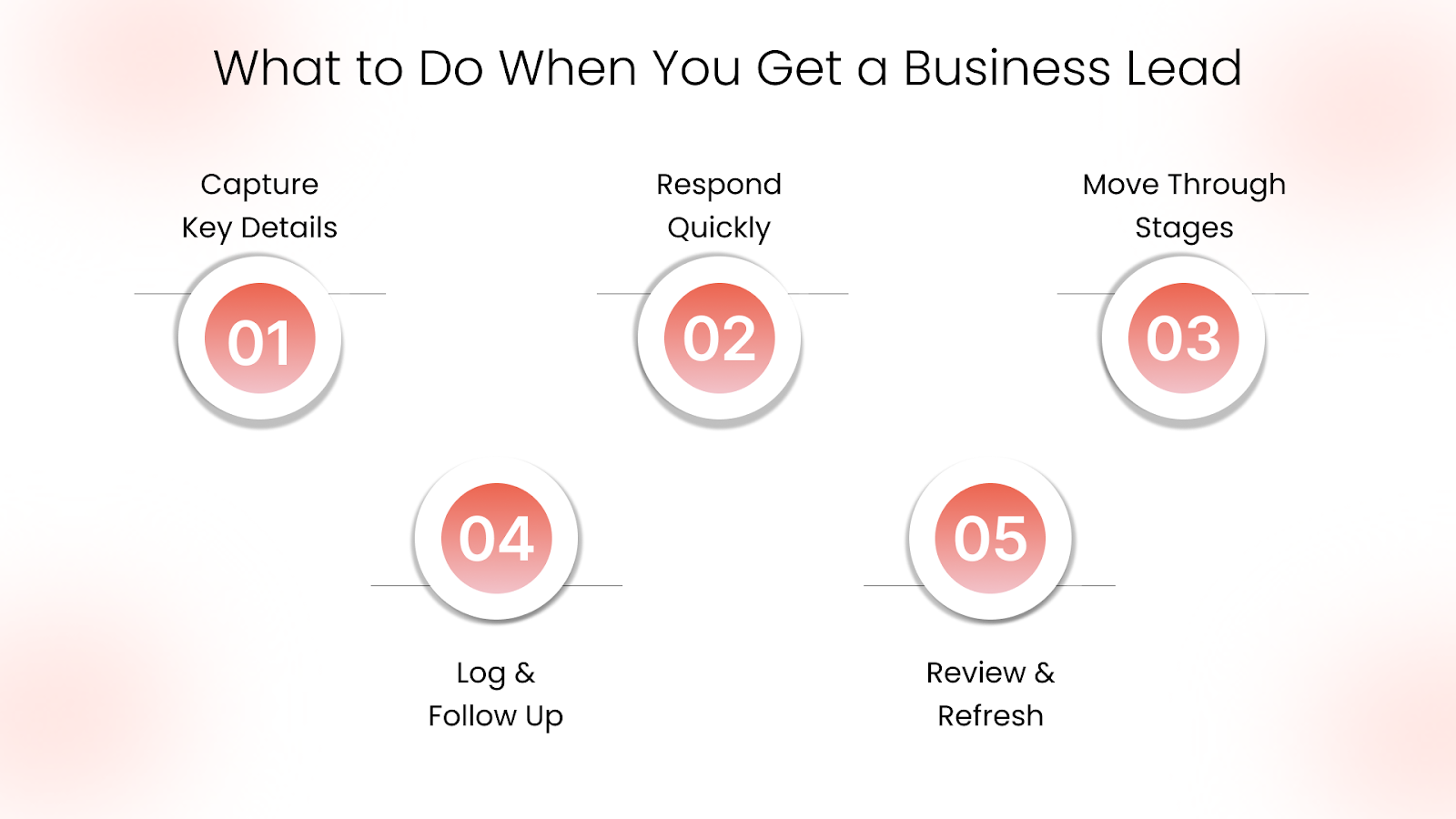
Getting a lead is just the beginning. What you do next determines if that interest turns into real revenue. A structured, timely, and personalized approach increases your chances of conversion and helps maintain a strong sales pipeline.
Here’s how to manage business leads effectively:
- Capture Key Details Early: Collect contact info, job role, company size, and pain points. Centralize this info to make future conversations more relevant and efficient.
- Respond Fast, Keep It Personal: Reach out within the first hour. Reference what the lead showed interest in to keep the conversation relevant.
- Move Leads Through Clear Stages: Track progress from “new” to “closed” using defined pipeline stages. This prevents stalls and gives your team visibility into what’s working.
- Log and Follow Up: Track every interaction using shared dashboards or internal trackers. Set clear next steps and reminders to keep momentum and prevent leads from slipping through the cracks.
- Review and Refresh: Regular list cleaning is essential to keep your outreach sharp. Remove bounced emails, outdated contacts, and consistently inactive leads. A cleaner list improves deliverability, boosts engagement rates, and ensures your messaging reaches the right people. You can also re-engage colder leads with a light-touch campaign before trimming them out for good.
Done right, lead management gives you structure, focus, and results. It ensures no opportunity is wasted and that your sales team always knows what to do next. However, if your team is stretched thin or struggling to maintain this process consistently, partnering with a trusted sales support partner can help.
How Can TLM Inside Sales Help You With Business Leads?
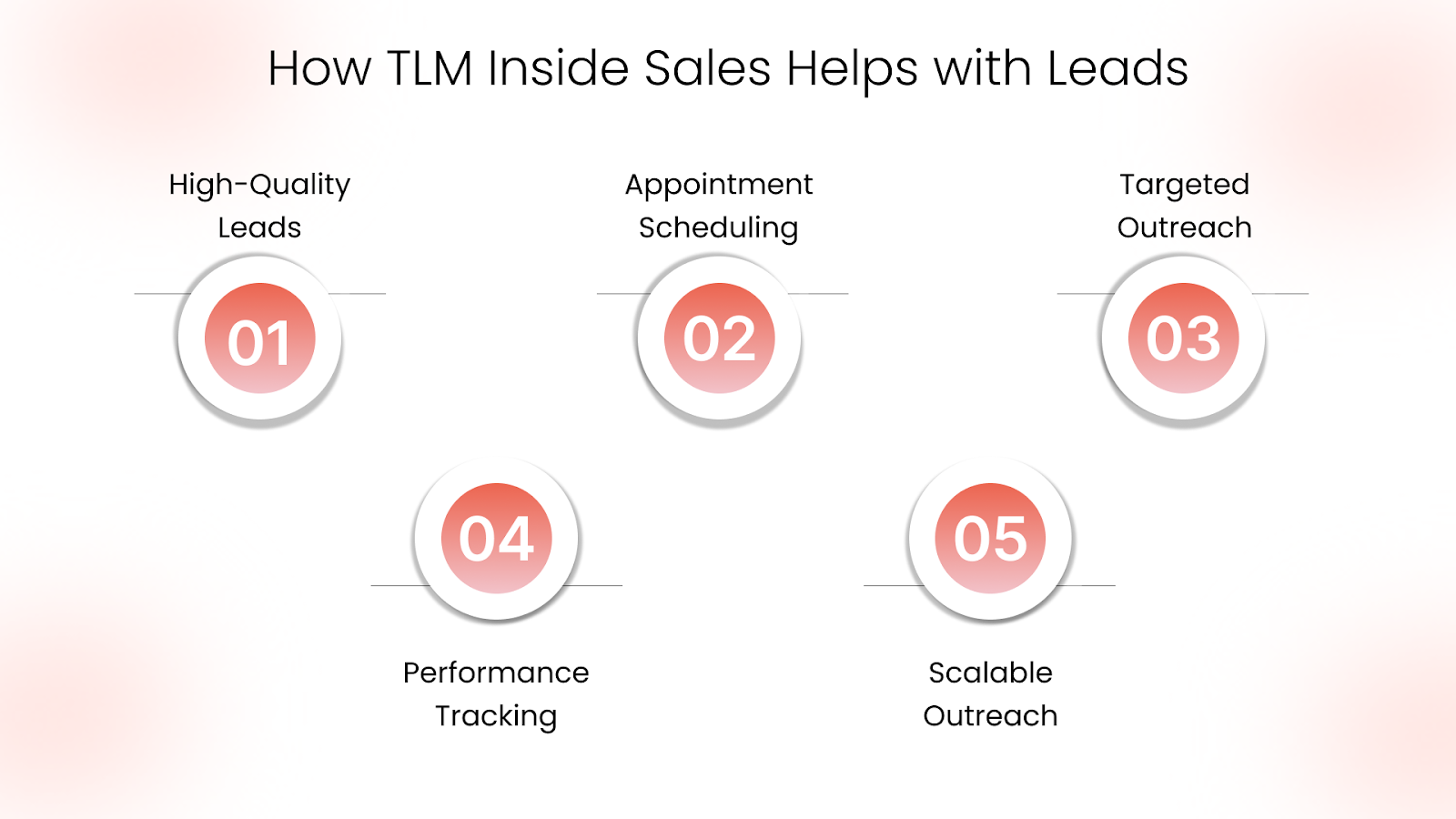
TLM offers services to deliver leads that match your business needs and support appointment scheduling. TLM turns lead generation into consistent business growth through focused and scalable strategies. Here’s what makes our approach effective:
- High-Quality Sales Qualified Leads (SQLs): We deliver leads that match your Ideal Customer Profile (ICP), improving conversion rates.
- Efficient Appointment Scheduling: Our process books meetings with decision-makers, speeding up sales cycles and increasing productivity.
- Targeted Account-Based Campaigns: Outreach focuses on high-value accounts, making your efforts more impactful.
- Real-Time Performance Tracking: Dashboards give clear insights into campaign results, allowing quick adjustments.
- Scalable Personalized Outreach: Customized email campaigns engage prospects at scale without losing relevance.
With extensive experience serving MSPs, staffing firms, technology companies, manufacturers, and warehousing businesses, TLM provides targeted B2B lead generation matched with your industry, demand generation, appointment setting with vetted prospects, and solutions that help maintain steady MRR growth to meet your specific sales needs.
Book a call with TLM to explore how our lead generation can fill your sales pipeline with qualified prospects.


